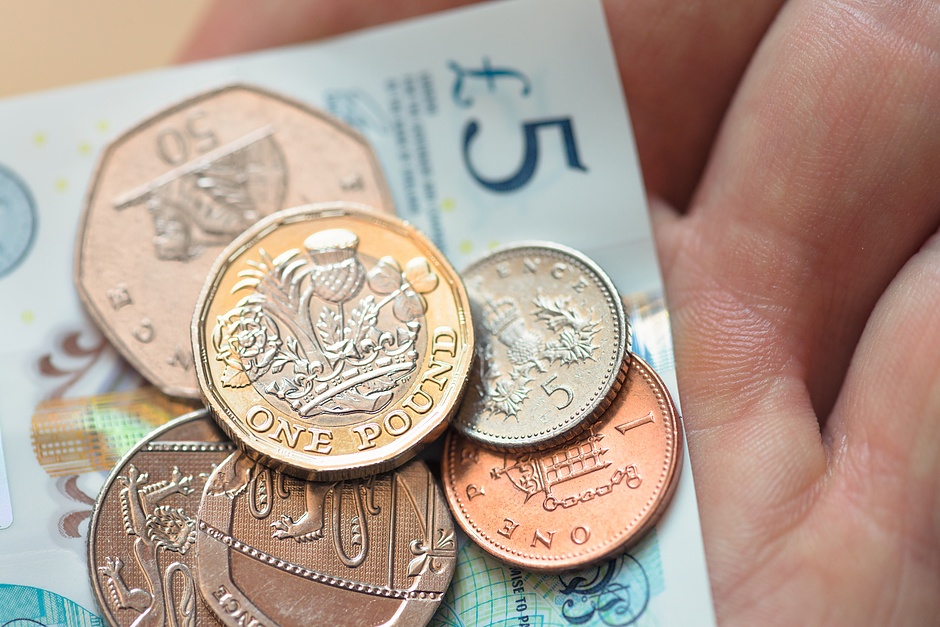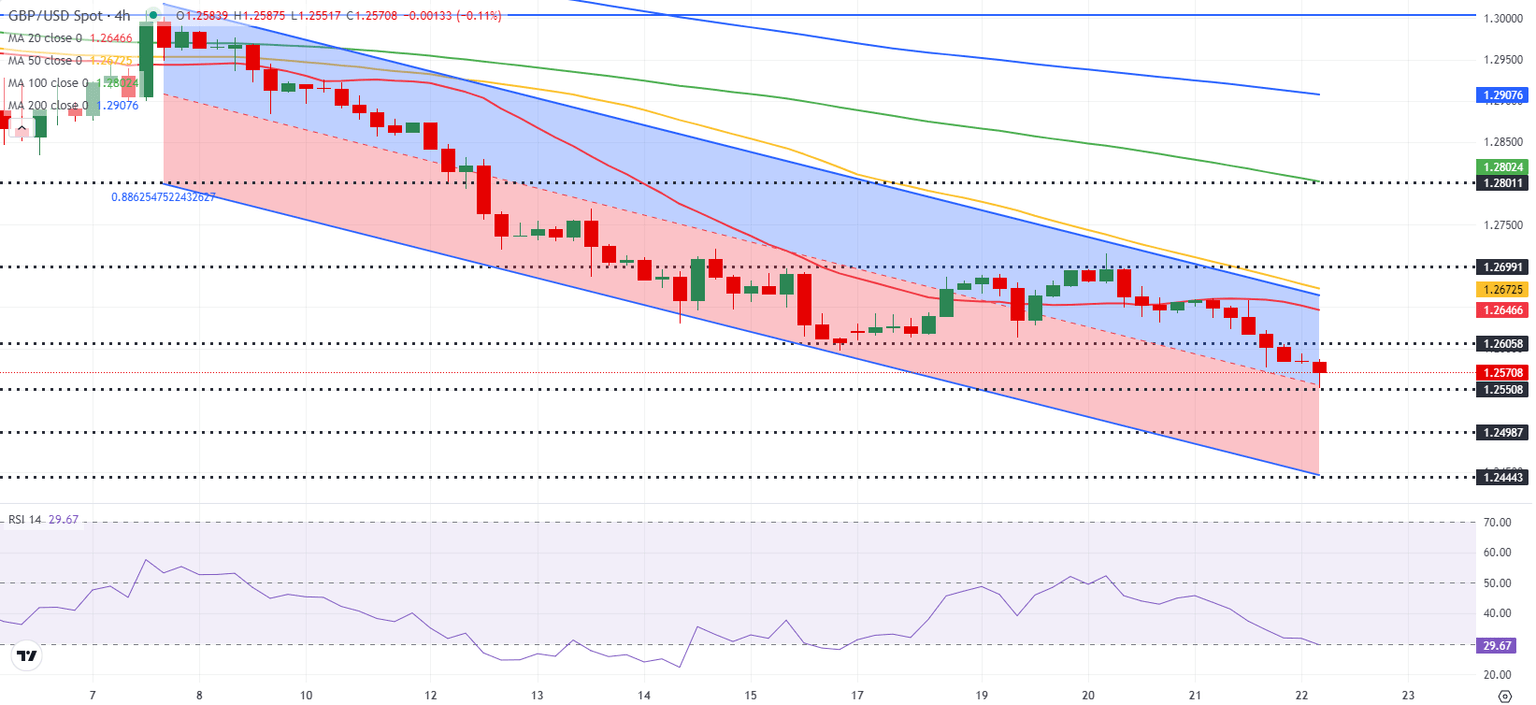GBP/USD Forecast: No signs of a steady Pound Sterling recovery
- GBP/USD slumped to its lowest level since May below 1.2600.
- Disappointing UK Retail Sales data weighs on Pound Sterling early Friday.
- Flash estimates for November PMI from the UK and the US will be watched closely.

After losing 0.5% on Thursday, GBP/USD continued to push lower in the Asian session on Friday and touched its lowest level since May near 1.2550. The pair seems to have turned technically oversold but recovery attempts could remain short-lived in the near term.
British Pound PRICE This week
The table below shows the percentage change of British Pound (GBP) against listed major currencies this week. British Pound was the weakest against the Canadian Dollar.
| USD | EUR | GBP | JPY | CAD | AUD | NZD | CHF | |
|---|---|---|---|---|---|---|---|---|
| USD | 0.53% | 0.39% | 0.36% | -0.84% | -0.66% | 0.48% | -0.23% | |
| EUR | -0.53% | 0.03% | -0.06% | -1.25% | -1.03% | 0.06% | -0.65% | |
| GBP | -0.39% | -0.03% | -0.10% | -1.28% | -1.07% | 0.03% | -0.69% | |
| JPY | -0.36% | 0.06% | 0.10% | -1.20% | -0.95% | 0.17% | -0.52% | |
| CAD | 0.84% | 1.25% | 1.28% | 1.20% | 0.20% | 1.32% | 0.60% | |
| AUD | 0.66% | 1.03% | 1.07% | 0.95% | -0.20% | 1.11% | 0.39% | |
| NZD | -0.48% | -0.06% | -0.03% | -0.17% | -1.32% | -1.11% | -0.71% | |
| CHF | 0.23% | 0.65% | 0.69% | 0.52% | -0.60% | -0.39% | 0.71% |
The heat map shows percentage changes of major currencies against each other. The base currency is picked from the left column, while the quote currency is picked from the top row. For example, if you pick the British Pound from the left column and move along the horizontal line to the US Dollar, the percentage change displayed in the box will represent GBP (base)/USD (quote).
The persistent US Dollar (USD) strength weighed on GBP/USD during the American trading hours on Thursday. The US Department of Labor reported that the weekly Initial Jobless Claims declined to 213,000 from 219,000, boosting the USD. Additionally, Federal Reserve Bank of Chicago President Austan Goolsbee said that it may make sense to slow the pace of interest rate cuts as they get close to where rates will settle, further supporting the currency.
Early Friday, the UK's Office for National Statistics (ONS) announced that Retail Sales declined 0.7% on a monthly basis in October. This reading followed the 0.1% increase recorded in September and came in worse than the market expectation for a decline of 0.3%, making it difficult for Pound Sterling to stay resilient against its major rivals.
Later in the session, S&P Global/CIPS will publish preliminary November Purchasing Managers Index (PMI) data for the UK. Markets expect the Composite PMI to match October's final reading of 51.8. A positive surprise in this data could help GBP/USD find a foothold. On the flip side, a print below 50 could trigger another leg lower in the pair.
In the American session, S&P Global will also release PMI data for the US. If the Manufacturing PMI recovers above 50, the USD could continue to outperform its rivals heading into the weekend.
GBP/USD Technical Analysis
The Relative Strength Index (RSI) indicator on the 4-hour chart stays slightly below 30. In case the pair stages a technical correction, 1.2600 (former support, static level) could be seen as immediate resistance before 1.2670 (50-period Simple Moving Average (SMA), upper limit of the descending regression channel) and 1.2700 (round level, static level).
On the downside, 1.2550 (mid-point of the descending channel) aligns as first support ahead of 1.2500 (round level, static level) and 1.2440 (lower limit of the descending channel).
Pound Sterling FAQs
The Pound Sterling (GBP) is the oldest currency in the world (886 AD) and the official currency of the United Kingdom. It is the fourth most traded unit for foreign exchange (FX) in the world, accounting for 12% of all transactions, averaging $630 billion a day, according to 2022 data. Its key trading pairs are GBP/USD, also known as ‘Cable’, which accounts for 11% of FX, GBP/JPY, or the ‘Dragon’ as it is known by traders (3%), and EUR/GBP (2%). The Pound Sterling is issued by the Bank of England (BoE).
The single most important factor influencing the value of the Pound Sterling is monetary policy decided by the Bank of England. The BoE bases its decisions on whether it has achieved its primary goal of “price stability” – a steady inflation rate of around 2%. Its primary tool for achieving this is the adjustment of interest rates. When inflation is too high, the BoE will try to rein it in by raising interest rates, making it more expensive for people and businesses to access credit. This is generally positive for GBP, as higher interest rates make the UK a more attractive place for global investors to park their money. When inflation falls too low it is a sign economic growth is slowing. In this scenario, the BoE will consider lowering interest rates to cheapen credit so businesses will borrow more to invest in growth-generating projects.
Data releases gauge the health of the economy and can impact the value of the Pound Sterling. Indicators such as GDP, Manufacturing and Services PMIs, and employment can all influence the direction of the GBP. A strong economy is good for Sterling. Not only does it attract more foreign investment but it may encourage the BoE to put up interest rates, which will directly strengthen GBP. Otherwise, if economic data is weak, the Pound Sterling is likely to fall.
Another significant data release for the Pound Sterling is the Trade Balance. This indicator measures the difference between what a country earns from its exports and what it spends on imports over a given period. If a country produces highly sought-after exports, its currency will benefit purely from the extra demand created from foreign buyers seeking to purchase these goods. Therefore, a positive net Trade Balance strengthens a currency and vice versa for a negative balance.
Premium
You have reached your limit of 3 free articles for this month.
Start your subscription and get access to all our original articles.
Author

Eren Sengezer
FXStreet
As an economist at heart, Eren Sengezer specializes in the assessment of the short-term and long-term impacts of macroeconomic data, central bank policies and political developments on financial assets.


















